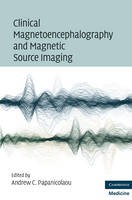
Clinical Magnetoencephalography and Magnetic Source Imaging
Cambridge University Press (Verlag)
978-0-521-87375-8 (ISBN)
This is the first volume to explore the field of clinical magnetoencephalography (MEG) and magnetic source imaging (MSI), the techniques measuring the magnetic fields generated by neuronal activity in the brain. Describing the empirical knowledge gained during the last two decades, this book will serve as a basis for the training of clinicians and scientists entering this new and exciting field. The book covers the methods for recording MEG and performing MSI in a clinical setting and includes practical examples of data collection and analysis. It explains why MEG should be used in the evaluation and treatment of patients being considered for epilepsy surgery, concluding with a section describing the potential for future applications of these methods. This is essential reading for graduate students in clinical neuroscience, residents in neurology and psychiatry, neuroradiology and neurosurgery, specialists in neurophysiology and epilepsy, and clinicians in a wide range of related brain sciences.
Andrew C. Papanicolaou is Professor, Department of Pediatrics and Departments of Neurology and Neurosurgery, the University of Texas Medical School at Houston, Houston, Texas, USA.
Preface; Part I. The Method: 1. Basic concepts; 2. The nature and origin of magnetic signals; 3. Recording the magnetic flux; 4. Overview of MSI using the single equivalent current dipole (ECD) model as an example; 5. The fundamental problems of MSI; 6. Head models; 7. Source models - discrete source models; 8. Source models - distributed source models; 9. Source models - beamformers; 10. Pragmatic features of the clinical use of MEG/MSI; References; Part II. Spontaneous Brain Activity: 11. MEG recordings of spontaneous brain activity - general considerations; 12. Normal spontaneous MEG frequently encountered artefacts; 13. Spontaneous MEG morphology; 14. Abnormal spontaneous MEG; 15. Contributions of MEG to the surgical management of epilepsy - general considerations; 16. MEG investigations in lesional epilepsies; 17. MEG investigations in nonlesional epilepsies; 18. Pediatric nonlesional epilepsy surgery; References; Part III. Evoked Magnetic Fields: 19. Recording evoked magnetic fields (EMFs); 20. Somatosensory evoked fields (SEFs); 21. Movement-related magnetic fields (MRFs) - motor evoked fields (MEFs); 22. Auditory evoked magnetic fields (AEFs); 23. Visual evoked magnetic fields (VEFs); 24. Language-related brain magnetic fields (LRFs); 25. Alternative techniques for evoked magnetic field data - future directions; References; Postscript: Future applications of clinical MEG; Overview; Normal aging and neurodegenerative disorders; Neurodevelopmental disorders; Psychiatric disorders; Neurological disorders; Functional reorganization; References; Index.
| Erscheint lt. Verlag | 13.8.2009 |
|---|---|
| Zusatzinfo | 32 Halftones, unspecified |
| Verlagsort | Cambridge |
| Sprache | englisch |
| Maße | 160 x 240 mm |
| Gewicht | 600 g |
| Themenwelt | Medizin / Pharmazie ► Medizinische Fachgebiete ► Neurologie |
| Medizin / Pharmazie ► Medizinische Fachgebiete ► Radiologie / Bildgebende Verfahren | |
| ISBN-10 | 0-521-87375-4 / 0521873754 |
| ISBN-13 | 978-0-521-87375-8 / 9780521873758 |
| Zustand | Neuware |
| Haben Sie eine Frage zum Produkt? |
aus dem Bereich


